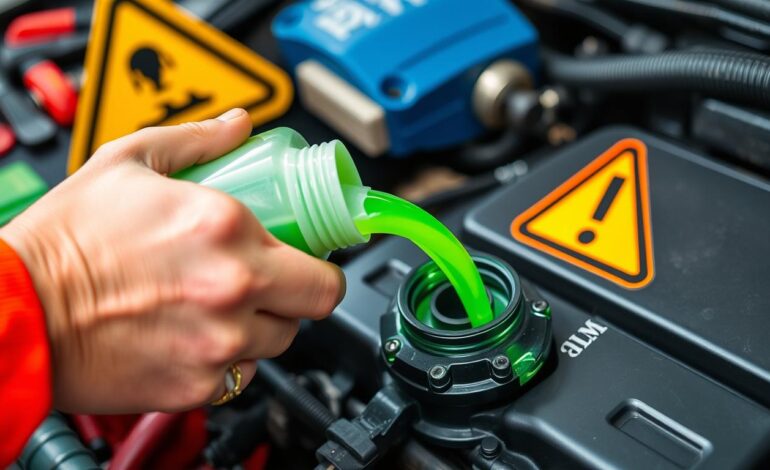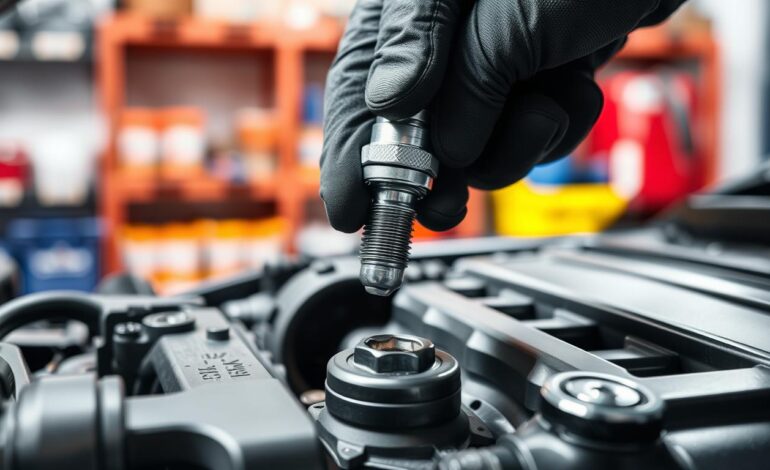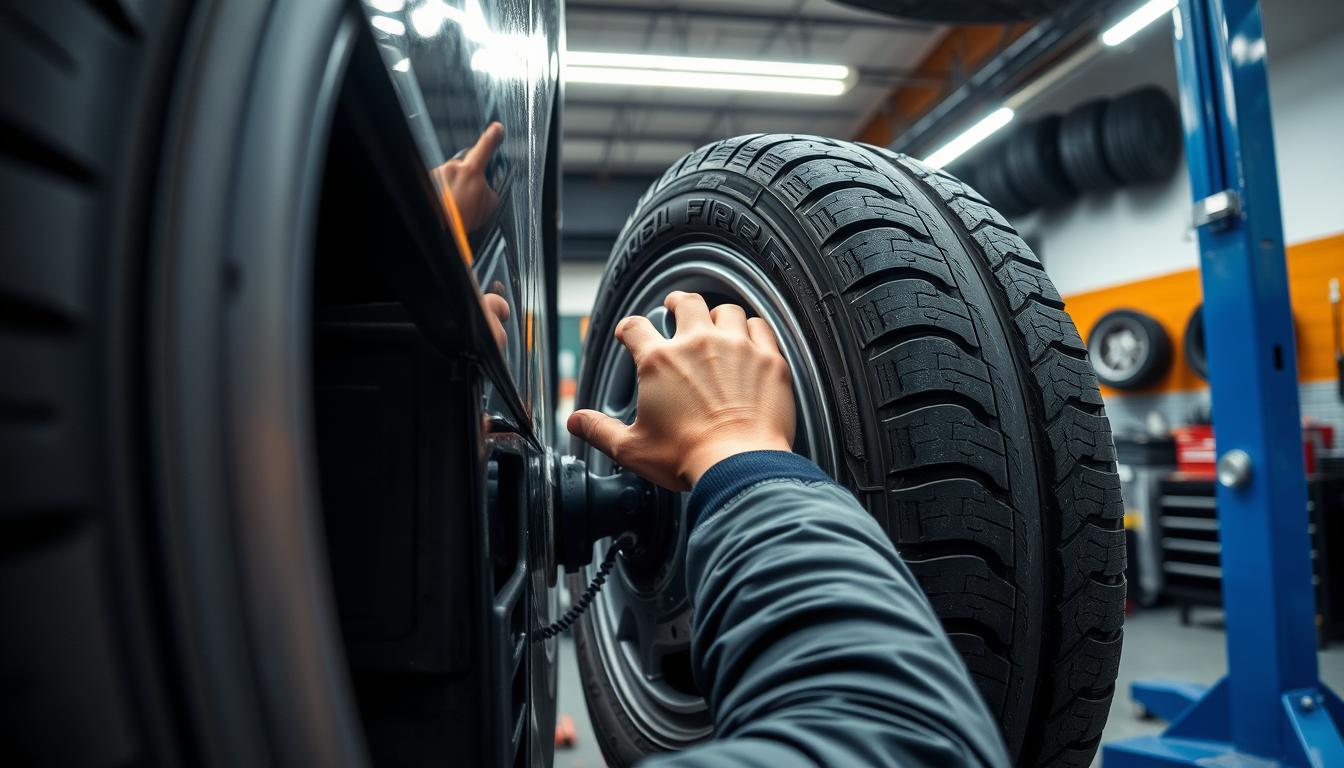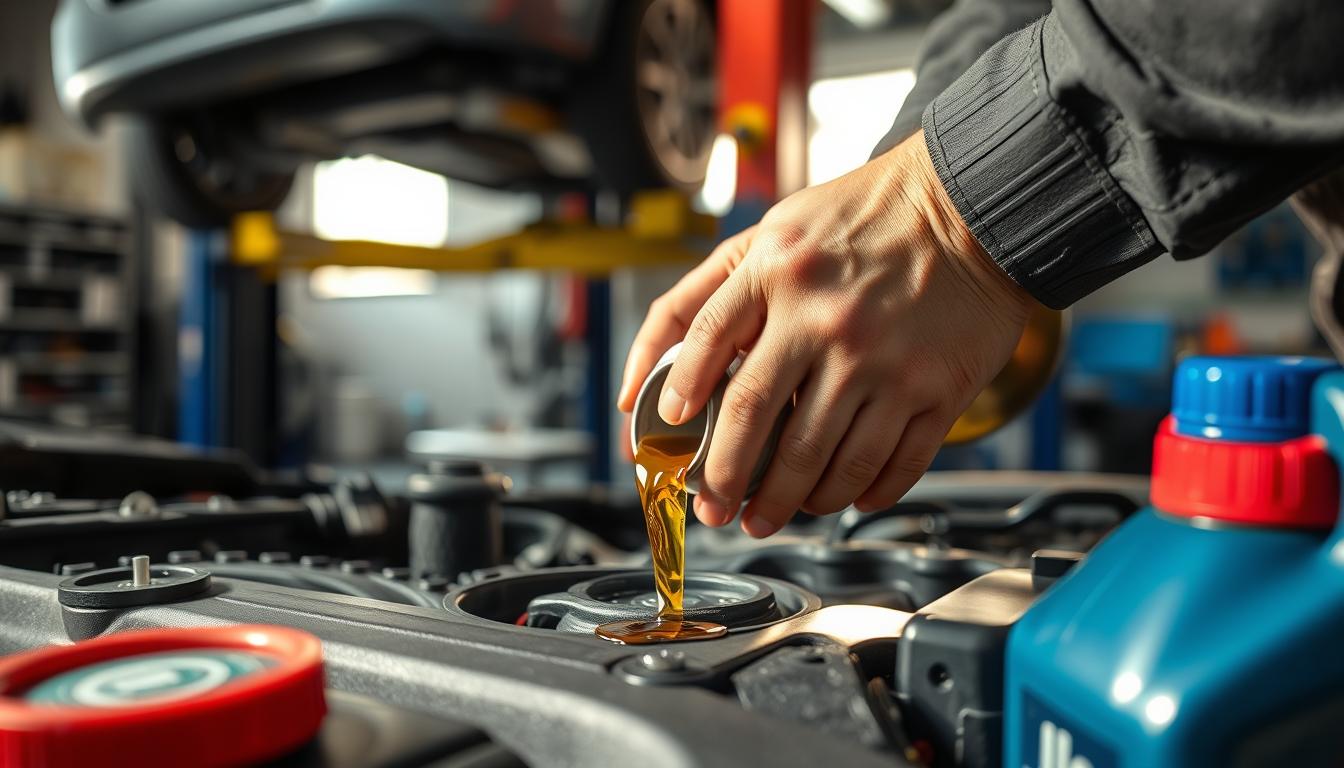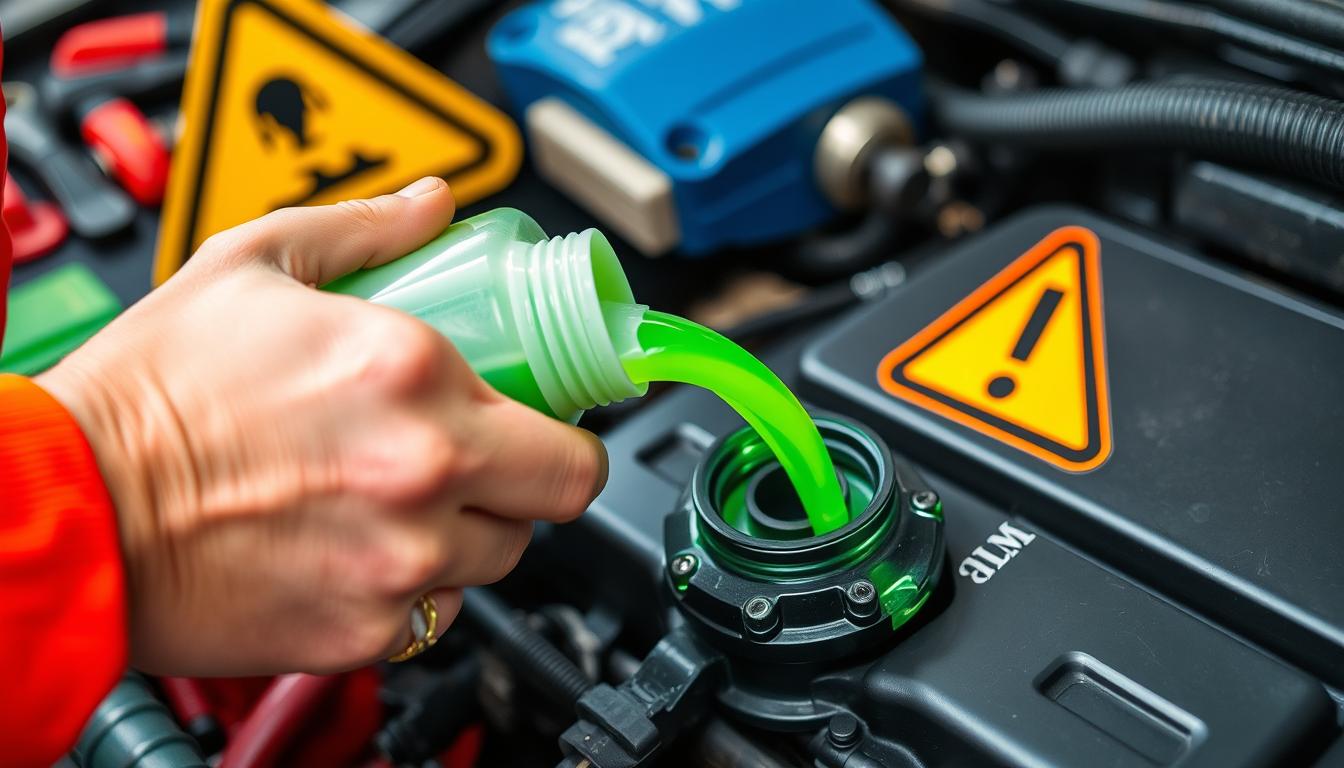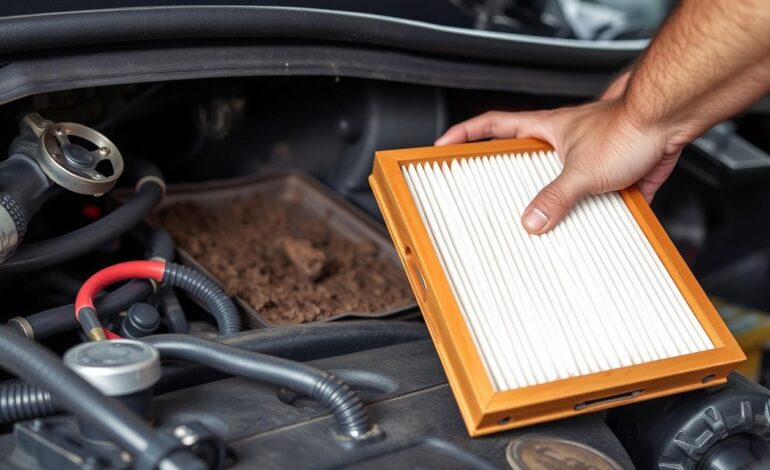
The Complete Guide to Replacing Air Filters in Any Vehicle
Replacing your vehicle’s air filter is a key maintenance task. It greatly affects your car’s performance and how much fuel it uses. You can do this yourself with some simple steps.
Whether you love DIY projects or are a pro mechanic, knowing about air filter replacement is vital. This guide will give you expert tips. You’ll learn how to replace air filters in cars, trucks, and SUVs easily.
Key Takeaways
- Regular air filter replacement is essential for optimal vehicle performance
- Air filter DIY methods can be cost-effective and easy to follow
- Understanding the different types of air filters is key for the right choice
- Air filter replacement can improve fuel efficiency and reduce emissions
- Following the correct steps is essential for a successful air filter replacement
- Air filter maintenance is a key part of overall vehicle maintenance
Understanding Vehicle Air Filters and Their Importance
Air filters are key to keeping your vehicle’s engine running well. They clean the air by removing dirt and dust. This ensures the engine gets clean air for burning fuel. Replacing the air filter regularly is important for your vehicle’s health.
To replace air filter right, knowing the different types is essential. You’ll find paper, foam, and cotton filters, each with its own benefits. The right filter depends on your vehicle, how you drive, and what you prefer.
Types of Air Filters in Modern Vehicles
- Paper air filters: These are the most common type of air filter and are known for their affordability and ease of replacement.
- Foam air filters: These filters are more durable than paper filters and can be washed and reused, making them a popular choice for off-road vehicles.
- Cotton air filters: These filters are designed for high-performance vehicles and provide better airflow and filtration than traditional paper filters.
How Air Filters Impact Engine Performance
A dirty or clogged air filter can hurt your engine’s performance. It can lead to less power, worse fuel efficiency, and more emissions. Regular engine care and air filter changes can prevent these problems. This keeps your vehicle running smoothly and efficiently.
Signs Your Air Filter Needs Replacement
Some signs your air filter needs a change include lower fuel efficiency, less engine power, and odd engine sounds. If you see these signs, it’s time to replace air filter. This will help avoid engine damage.
| Signs of a Dirty Air Filter | Consequences of Not Replacing |
|---|---|
| Decreased Fuel Efficiency | Increased Fuel Costs |
| Reduced Engine Power | Decreased Vehicle Performance |
| Unusual Engine Sounds | Potential Engine Damage |
Essential Tools and Materials for Air Filter Replacement
For air filter DIY projects, the right tools and materials are key. They help make sure your engine care is done right. You’ll need a new air filter, a screwdriver, a socket wrench, and gloves to keep your hands clean.
Here’s what you’ll need for the job:
- A new air filter that fits your vehicle
- A screwdriver for taking out screws and clips
- A socket wrench for removing bolts and nuts
- Gloves to protect your hands
- A car jack and jack stands for getting to the air filter from underneath, if needed
Always check your vehicle’s manual for the best way to replace the air filter. By following these steps and using the right tools, you’ll do a great air filter DIY job. This ensures your engine care is top-notch.
With the right tools and materials, you’re ready to replace the air filter. This will keep your vehicle running well and efficiently.
Locating Your Vehicle’s Air Filter Housing
Finding your vehicle’s air filter housing is the first step to replace it. The location varies by vehicle type. You’ll need to check your vehicle’s manual or look for a diagram to find it.
The air filter housing is often in the engine compartment. It’s secured by screws or clips. To safely access it, disconnect the battery and use a car jack and jack stands. This ensures you can work without the vehicle falling.
Common Air Filter Locations
Here are some common spots for the air filter housing in different vehicles:
- Cars: usually on the driver’s side of the engine compartment
- Trucks: often on the passenger’s side of the engine compartment
- SUVs: can be on either side, depending on the make and model
After finding the air filter housing, you can start replacing the air filter. This is a simple task that requires a few tools and basic knowledge.
Always follow safety procedures when working on your vehicle. If unsure, check your owner’s manual. With practice and patience, you’ll replace your air filter like a pro and keep your vehicle running well.
Step-by-Step Air Filter Replacement Guide
Replacing your vehicle’s air filter is key for engine care. A dirty air filter can harm your engine and lower fuel efficiency. We’ll guide you through air filter replacement step by step for a successful swap.
First, gather your tools and materials. You’ll need a new air filter, a screwdriver, and gloves. Also, check your vehicle’s manual for specific instructions.
Removing the Old Air Filter
Find the air filter housing in the engine compartment. Open it and pull out the old filter. Be careful not to touch any electrical parts.
Cleaning the Air Filter Housing
After removing the old filter, clean the housing with a soft brush or cloth. This removes dirt and debris.
Installing the New Air Filter
Put the new air filter in the housing. Make sure it fits right and the housing is closed. Start the engine and listen for any leaks or odd noises.
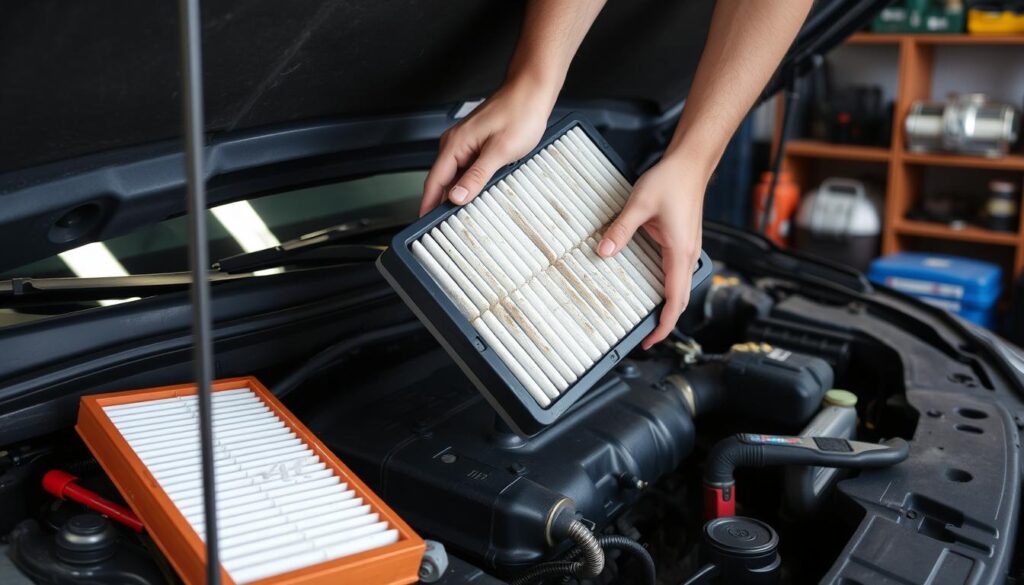
By following these steps, you’ll replace your air filter successfully. Regular checks and replacements keep your engine in top shape. Remember, a clean air filter is essential for engine care.
| Step | Description |
|---|---|
| 1 | Locate the air filter housing |
| 2 | Remove the old air filter |
| 3 | Clean the air filter housing |
| 4 | Install the new air filter |
Common Mistakes to Avoid During Replacement
Replacing an air filter is important for your vehicle’s performance. A big mistake is not disconnecting the battery first. This can cause electrical shocks or harm your car’s electrical system. Always disconnect the battery and wait a few minutes before starting the air filter DIY replacement.
Using the wrong tools is another mistake. The wrong tools can damage the air filter housing or other parts, costing you money. Use the right tools and follow the manufacturer’s instructions for a smooth replacement. Also, not securing the new air filter properly can hurt your engine’s performance and fuel efficiency. When you replace air filter, make sure it’s securely in place.
- Not cleaning the air filter housing before installing the new filter
- Not checking the air filter for any damage or defects before installation
- Not following the manufacturer’s instructions for replacement
Avoiding these mistakes will help you replace the air filter successfully. Always follow the manufacturer’s instructions and take precautions to protect your vehicle.
Choosing the Right Air Filter for Your Vehicle
Choosing the right air filter is key for your vehicle’s engine care. With many options, it’s important to think about a few things. This will help you make a good choice.
First, consider the type of filter: OEM or aftermarket. OEM filters fit your vehicle perfectly and work best. Aftermarket filters might be cheaper but are also good.
Understanding Filter Specifications
It’s also important to know about filter specs. Look at the material, thickness, and MERV rating. A higher MERV means better air cleaning.
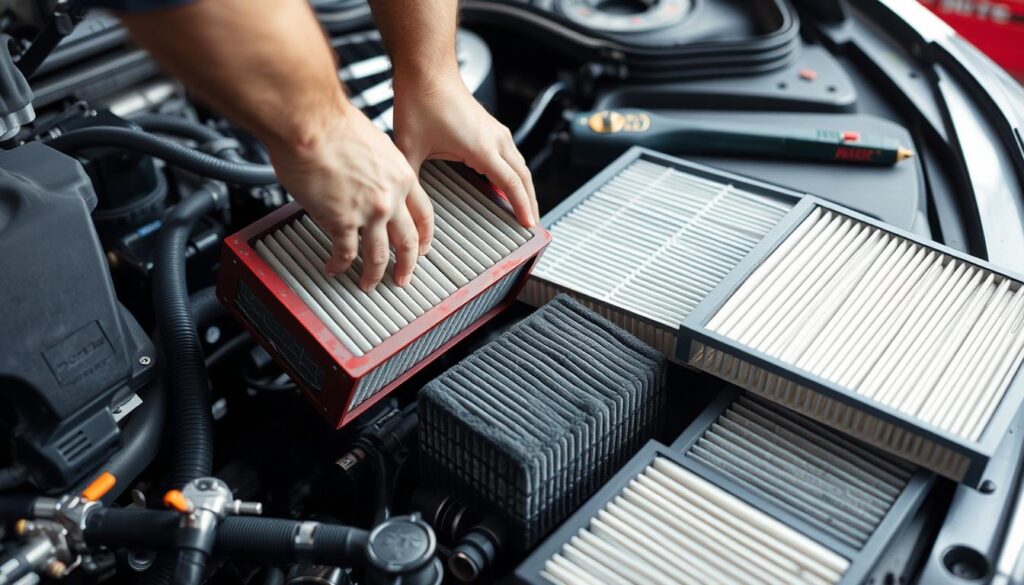
Price vs. Quality Considerations
Price matters, but don’t forget about quality. A cheap filter might not last as long or clean as well as a pricier one. Think about these things when you decide:
- How long the filter lasts
- How well it filters the air
- If it fits your vehicle
- What kind of warranty and support it has
By looking at these points and what your vehicle needs, you can pick the best air filter. This will help your engine care and performance.
| Filter Type | MERV Rating | Price Range |
|---|---|---|
| OEM | 11-13 | $15-$30 |
| Aftermarket | 9-12 | $10-$25 |
Maintenance Schedule and Best Practices
Regular maintenance is key to keeping your vehicle in top shape. For air filter DIY tasks, setting up a routine is vital. It’s best to replace the air filter every 15,000 to 30,000 miles. The exact time may change based on how you drive and the air filter’s type.
Here are some best practices to follow:
- Check the air filter every 7,500 to 10,000 miles for dirt and debris.
- Regularly clean the air filter housing to stop dust and dirt buildup.
- Pick the right air filter for your vehicle, considering type, size, and material.
By sticking to these tips and adding replace air filter tasks to your routine, you can boost your vehicle’s fuel efficiency and performance. Always check your vehicle’s owner’s manual for air filter maintenance and replacement advice.
Also, consider the following table for a general outline of air filter maintenance:
| Mileage | Air Filter Maintenance |
|---|---|
| 7,500 – 10,000 miles | Inspect air filter |
| 15,000 – 30,000 miles | Replace air filter |
| Every 1-2 months | Clean air filter housing |
Special Considerations for Different Climate Conditions
Climate conditions are key when it comes to air filter replacement and engine care. Different environments can impact your air filter’s performance and lifespan. It’s vital to think about these factors when keeping your vehicle in top shape.
In places with extreme temperatures or lots of dust and humidity, replacing your air filter regularly is a must. For example, in desert and dusty areas, air filters can get clogged faster. This can hurt your engine’s performance and fuel efficiency.
Desert and Dusty Environments
In these conditions, change your air filter every 15,000 to 30,000 miles. Also, using a top-notch air filter made for dusty places can help your engine last longer.
Cold Weather Maintenance
In cold weather, air filters can get brittle and crack easily. To avoid this, use a filter made for cold temperatures. Also, make sure to take good care of your engine to keep it running well.
Humid Climate Care
In humid climates, air filters can soak up moisture, which can lower engine performance. Regular air filter replacement and engine care can stop this problem. This ensures your vehicle runs smoothly.
By keeping these climate conditions in mind and taking the right steps in air filter replacement and engine care, you can make your engine last longer. This will also help keep your vehicle performing at its best.
Troubleshooting Post-Replacement Issues
After doing an air filter DIY project, some car owners might see engine performance problems. It’s key to find out why this is happening. If you’ve just put in a new air filter, you might notice your engine isn’t as strong or it idles roughly.
To fix these issues, first check how well the replace air filter was installed. Make sure the new filter fits right and is locked in place. If it’s not installed right, it can mess with your engine’s performance. Look in your car’s manual for how to install it correctly.
Common Issues and Solutions
- Engine hesitation or stalling: Check the air filter housing for any blockages or debris.
- Poor fuel economy: Ensure the new air filter is the correct type and size for your vehicle.
- Unusual engine noises: Inspect the air filter housing and surrounding components for any signs of damage or wear.
If you can’t fix the problem yourself, you might need a pro’s help. A skilled mechanic can find out what’s wrong and fix it. Always stick to your car’s maintenance schedule, including regular air filter DIY changes, to keep it running well.
Conclusion: Maintaining Your Vehicle’s Air Filter for Optimal Performance
Keeping your air filter in good shape is key for your vehicle’s top performance. Regular air filter changes and clean housing improve engine efficiency and fuel economy. The air filter shields your engine from harmful particles, making it a vital engine care task.
It doesn’t matter if you drive a sedan, truck, or SUV. The air filter replacement rules are the same. By following the guide in this article, you can do this maintenance task well. With the right knowledge and effort, your vehicle will run smoothly for many years.

